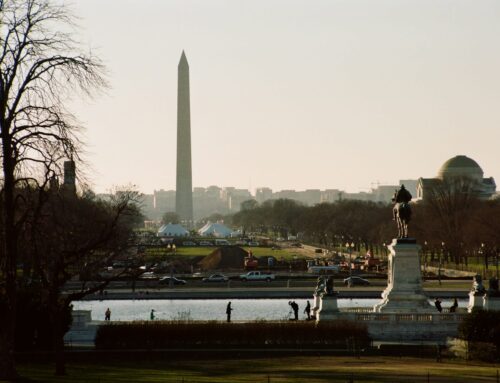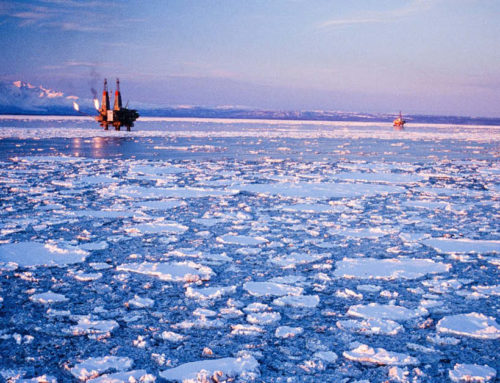Growing up in Midland, John Northington looked out over the flat, featureless landscape and saw oil country ready and waiting to be drilled.
A fourth generation oil worker who advises energy companies like Exxon Mobil and EOG Resources as a consultant in Washington, Northington equated oil with American industriousness and prosperity. Still does. But as President Donald Trump opens vast swaths of the West to energy production, Northington worries the administration is going too far, recalling a trip to northeast Utah in the 1990s and the stunning beauty of the desert and the mesas rising around him.
“The guy I was traveling with threw two spares in the back of a truck because if you blow a tire out there, there’s nobody to call. It was incredible to me. I’d never been in a place so open. No telephone lines, no houses around. You feel like you’re on another planet,” he said. “There are some places too special, you don’t need to try and produce from.”
Since taking office last year, Trump has undertaken an unprecedented saleof the nation’s public lands to energy companies, auctioning an amount of acreage that environmentalists say is unlike anything in the modern era while pulling back regulations designed to protect America’s western wilderness. Oil and gas companies from Texas and beyond are buying access to lands in the Rocky Mountains and the high plains of Wyoming and Montana that many viewed as off limits during more than a century of American conservation efforts.
Last year, the Department of Interior put almost 12 million acres of federal land on the block, more than double what was auctioned at the peak of the George W. Bush administration, according to leasing data compiled by the Natural Resources Defense Council. And now the administration is opening up drilling in some of the country’s most beloved and remote wilderness.
Already in 2018, Trump administration has sold off parcels just outside Dinosaur National Monument on the Colorado-Utah border, a canyon that President Woodrow Wilson protected in 1915 after the discovery of thousands of fossils there. Likewise, parcels in between Canyonlands National Park and Hovenweep National Monument in southeast Utah, framed by striking sandstone formations and historic Native American dwellings, were auctioned to oil and gas companies despite objections from the National Park Service.
Just outside Grand Canyon National Park, a ban on uranium mining enacted to keep radioactive pollution from flowing into the Colorado River is under review by Interior for possible reversal. And despite a bipartisan deal years in the making to protect the greater sage grouse, a threatened species of bird that resides in the western high plans, the Trump administration has dramatically increased the amount of acerage available for drilling in its territory, according to analysis by The Wilderness Society.
These moves follow Trump’s decision to dramatically shrink the boundaries of the Bears Ears and Grand Staircase-Escalante national monuments in Utah, making more land available for drilling and mining. With the admnistration considering similar actions at two more monuments in California and Nevada, even Republicans question whether Trump is turning the Interior Department into a vehicle for producing oil.
“Managing federal lands is supposed to be a balancing act,” said Lynn Scarlett, the former deputy interior secretary during the George W. Bush administration, now global chief policy officer at The Nature Conservancy. “With Bears Ears and Grand Staircase shrinking, which have some energy and mineral resources, it means certain areas that would have not have been open for leasing and development are now fair game.”
Heather Swift, a spokeswoman for the Interior Department, denied the administration was prioritizing energy over conservation and other land uses. She cited Secretary Ryan Zinke’s decisions to preserve the corridors of lands through which migrating wildlife travel and set aside “thousands of acres in New Mexico,” as wilderness area.
“Everything is carefully determined on a case by case basis,” Swift said. “The idea that the only thing the department is doing is energy is patently false.”
The Breaks
The push to put more oil and gas wells on federal lands – part of Trump’s “energy dominance” strategy – follows decades of regulation designed to reduce the impact of oil companies, ranchers, lumber jacks and motorized ATVs on America’s wilderness. Those regulations have put a significant number of potential oil and gas fields out of bounds, said Kathleen Sgamma, president of industry group Western Energy Alliance.
At the height of the fracking boom – from 2006 to 2015 – natural gas production from federal land declined, even as production on private land almost doubled, according to the Congressional Research Service.
“Every year [the federal government] comes up with more designations that restrict access,” Sgamma said.
The Upper Missouri Breaks, a rocky stretch of the Missouri River, is a popular destination for Montana hikers and hunters on the trail of elk and deer. Declared a national monument by former president Bill Clinton, the area was first mythologized by Lewis and Clark on their expedition to map the western United States in the early 1800s.
“The bluffs of the river rise to a height of from 2-to-300 feet and in most places nearly perpendicular,” Capt. Meriwether Lewis wrote in his journal. “So perfect indeed are those walls that I should have thought that nature had attempted here to rival the human art of masonry.”
In March, the Interior Department auctioned a 200-acre parcel on the boundary of the monument to Lonewolf Energy, a small oil and gas company in Billings, Mont. Natural gas deposits underlie the area, but recent administrations have been reluctant to allow drilling there, said Trent Sizemore, founder and CEO of the company.
“The leases they were offering [in March] were nominated 11 to 12 years ago,” he said. “Just because I might get to lease something, that doesn’t mean I can drill anywhere I want. Leases come with a lot of stipulations.”
But the listing of land in the Upper Missouri was too much for Whit Fosburgh, who penned a letter of support for Interior Secretary Ryan Zinke during his confirmation. Fosburgh, head of the Theodore Roosevelt Conservation Partnership, which lobbies to protect habitat on behalf of hunters and fishermen and counts a former vice president of the oil services giant Schlumberger as its chairman, said he worried the administration was abandoning its mission to protect federal lands.
“I drive a car and heat my house,” he said.” I don’t have anything against oil and gas development, but where we get frustrated is hearing expand oil and gas over everything else.”
Bargain basement prices
So far, the only thing that has slowed development of some of the country’s most wild and pristine land has been depressed natural gas prices. With gas prices at historic lows – a consequence of abundant gas flowing from shale fields in Texas and Pennsylvania – drilling on federal lands, which carry increased costs relative to private leases, hasn’t been so attractive.
Of almost 12 million acres put up for auction last year, fewer than 800,000 acres received bids. That has meant considerable bargains.
Lonewolf Energy, for example, paid just $2 an acre – the federal minimum – for its 200 acre lease in Montana, which is good for 10 years. The company doesn’t expect to develop the land anytime soon, but should oil and gas prices pick up, new wells could be drilled, Sizemore said.
“We bought it because no one else was bidding,” he said. “I paid peanuts for all the leases I bought that day.”
With bidding interest so low, budget hawks say, auctioning so many leases is neither good business nor good policy, ultimately benefiting private interests while delivering tiny returns to U.S. taxpayers who own the land. The nonpartisan Taxpayers for Common Sense said in an October report that speculators were swooping in to buy leases with no intention of drilling, looking to flip leases at a profit if the market improves.
So far, large companies, household names like Exxon Mobil and BP, have largely stayed away from leasing in wilderness areas that could arouse controversy, said Northington, the oil consultant and a member of the National Petroleum Council, which advises the federal government on oil and gas policy. The fear among oil majors and big independents, he said, is the rapid expansion of drilling on public lands will provoke a public backlash and tougher regulations when the next president takes office.
“There is a tacit acknowledgment that a lot of what the administration is doing is backfiring on the industry and (oil and gas companies are) going to pay the price,” Northington said. “As of yet, there isn’t the momentum to publicly say so.”
Limits
Conservation groups have long found ways to delay and block efforts to extract resources from federal lands, whether natural gas in Utah or timber in Oregon. Activists will try to turn public opinion against drilling by protesting lease sales – as they did on the National Mall earlier this month under a cutout of a 10-foot tall oil pump jack – and file lawsuits that can tie up projects for years.
But these days, they are straining to stay on top of which parcels of land are on the block.
“There’s this fire sale mentality. And it’s happening so fast, it’s a little dizzying to keep up,” said Bobby McEnaney, a senior deputy director at the Natural Resources Defense Council. “We’re hearing about leases all over the West. They’re entertaining the ideas of leasing in places that had never been leased before.”
Conservationists, however, have had some notable wins. In March, Zinke deferred a lease sale near New Mexico’s Chaco Canyon – the site of Native American ruins dating back a millennia – after protest by local tribes.
And Zinke stopped another oil and gas auction for lands outside Zion National Park in Utah following a public outcry. State officials there have long argued that federal control of so much land represents an unfair economic burden on their state, but those controls have also preserved a natural landscape that supports a major tourism industry, with visitors from around the globe flocking to Utah’s famed national parks and monuments.
“The preservation of this unique experience is important to the surrounding communities,” Utah Gov. Gary Herbert, a Republican, wrote to the Interior Department in May to oppose the leases near Zion. “Their economy is dependent upon recreation and tourism.”
Zinke, a former Montana congressman and Navy SEAL, speaks often of his commitment to conservation, describing himself as following in the tradition of President Theodore Roosevelt – who put 230 million acres across the West under federal protection. Zinke keeps a bust of Roosevelt in his office overlooking the National Mall.
But that didn’t stop the Interior Department from last year announcing an oil and gas lease sale for 120 acres on the boundary of Theodore Roosevelt National Park in North Dakota, drawing protests from conservationists. The sale was ultimately deferred in December without explanation.










